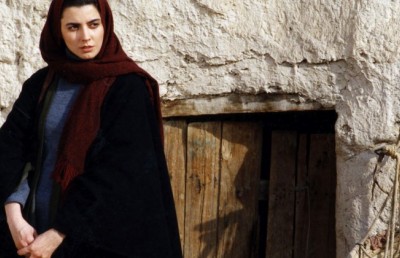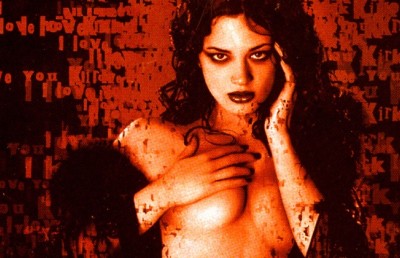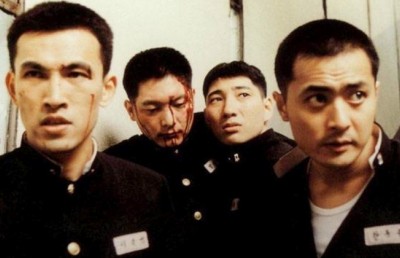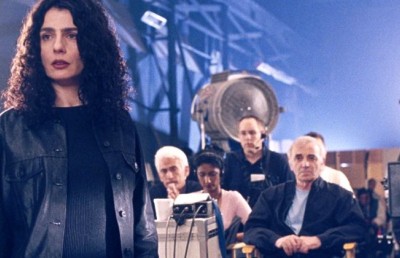A Touch of Hu: A Fan’s Notes and an Appreciation
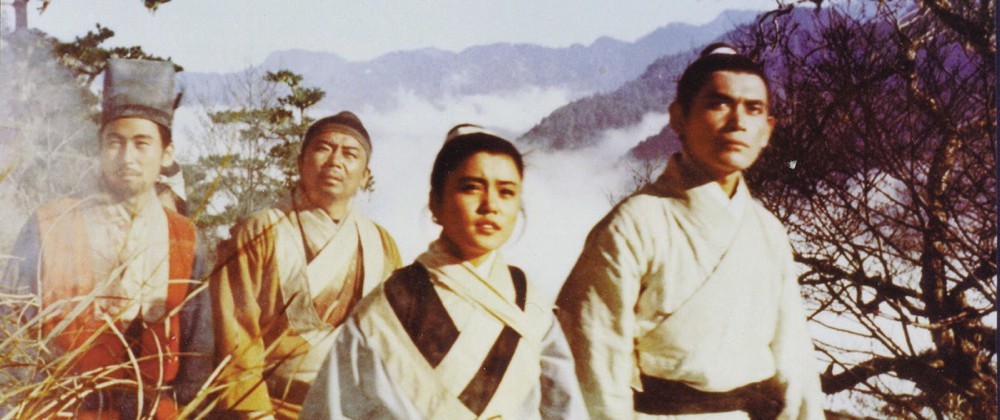
On Sunday, September 2nd, 1979, at the Cinéma Parisien in Montreal, Quebec, Canada, I saw a film which changed my life, Kongshan Lingyu (Raining in the Mountains), made by King Hu. (He was truly the “author” of the film, being credited with the screenplay, direction, art direction and editing). I was soon to return to New York City, where I was a student in the PhD Cinema Studies programme at NYU, and I was trying to watch films at the World Film Festival while working full-time as a mechanical engineer. At this phase of my studies, I was trying to watch everything. According to my records, Raining in the Mountains was the 627th film I had seen in 1979, and one of six features I saw that day. In my index card notes, I wrote that it was the “best film of the festival (so far) and the most beautiful film of the year.” In closing, I noted to myself that I “must now see all of his films.” This has not been easy to do, and, as of this writing, I have still yet to see a copy of one of the fourteen films on which he received credit as director, Dai Ernu (Sons of the Good Earth, 1965). Surprisingly, to me, no other opportunities presented themselves to see any King Hu films on screen while I shifted back and forth between Montreal and New York over the next two years, and in September 1981 I accepted a job offer in London, Ontario, a Canadian backwater for world cinema. It wasn’t until more than six months after I (thankfully) moved back East to fill a job at Concordia University, that I was finally able to see King Hu’s work again on a big screen, when Tammy Cheung the directrice of the late, lamented Festival international du cinéma chinois de Montréal brought 35mm prints from France of Raining in the Mountains and Xia Nü (A Touch of Zen, 1968–71) in May, 1990. My obsessive search was finally satiated…
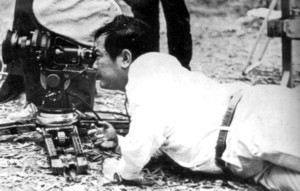
King Hu lining up a shot (photo taken from “Transcending the Times: King Hu & Eileen Chang”, The 22nd Hong Kong International Film Festival (Provisional Hong Kong Urban Council, 1998)
King Hu Jinquan (or, Chin-Chuan) is arguably the least appreciated “great director” in world film history. He should be better known as the most significant innovator of wu xia pian (especially the cape and sword genre) and its greatest practitioner. 1 Also, he needs to be recognised as one of the most truly original filmmakers of the 1960s and 1970s, alongside figures such as Miklós Jancsó (Hungary), Glauber Rocha (Brazil), Santiago Alvarez (Cuba), Andrei Tarkovsky (Russia), and, even, Jean-Luc Godard (France/Switzerland), all of whose artistry has less to do with narrative (story telling) and more with other aspects of film form or style. Unfortunately, experimental or avant-garde filmmaking has traditionally had few admirers or practitioners in the Chinese-speaking world, and in North America and Europe, King Hu’s aesthetic intentions have not been fully understood. The dance and musical-like nature of Hu’s work, which is more painterly and poetic than novelistic or dramatic, is now appreciated intrinsically and for its relevance to Chinese opera, painting and literature in Hong Kong, Taiwan and Japan, at least, but has not been championed on the world, film-historical stage. 2 (As an expatriate filmmaker who worked in the commercial film industries of Taiwan and Hong Kong, he remains virtually ignored in Mainland China, and, in any case, the Chinese are much too polite to boast about their own artistic heritage.)
Hu’s first wu xia pian, Come Drink With Me (Da Zui Xia, 1965–66) not only ushered in the first real wave of Hong Kong action films, but also stands out as being the film that completely changed the face of Chinese-language cinema for ever more. Of course, the literary genre of wu xiá is ancient, and the film genre is almost as old as film itself, in China. 3 Many silent martial arts/adventure films were made in Shanghai, but, traditionally, wu xia pian’s history had been hampered by unconvincing action and cinematic rendition as well as a general critical disdain for popular films. Even the work of the first major star of kung fu, Kwan Tak Hing who played the character Wong Fei Hung (or Huang Feihong) more than 75 times pales in comparison with the moves on display in Come Drink With Me. In the first of Kwan’s films, The True Story of Wong Fei Hung, Part 1: Whiplash Snuffs the Candle Flame (1949), one can see the roots of the Hong Kong action film, with acrobatic jumping from one level of an interior set to another, with the single protagonist in the centre of a circle of adversaries, and with sword, pole and unarmed combat. But there is little or no imagination in the filming of these scenes, and Kwan’s moves are un-athletic to say the least. Even in 1966, the year of Come Drink With Me’s release, we can find examples of commercially successful Hong Kong wu xia pian which look incredibly dated now. For example, The Jade Bow (directed by Zhang Xinyan and Fu Qi for Great Wall/Sil Metropole) is a highly entertaining and colourful film, with female characters in the principal action roles. It contains some imaginative special effects, but lacks the convincing action, deft editing and graceful movement of Come Drink With Me. Only a few moments of speeded-up action and some supernatural “special effects,” uncharacteristic of Hu’s developed style,—e.g., animated rays of chi emanating from the palms of human hands—hinder full appreciation today of this landmark film. It features the finest screen performance of Cheng (or Zheng) Pei Pei in, perhaps, the definitive prototypical role for warrior women in action. She is the central figure in a number of brilliantly choreographed fight scenes which include long tracking shots and cutting-on-movement, both of which enhance the film’s dynamism and beauty. The setting of an inn for one of the key sequences, where Golden Swallow (Cheng) catches coins on a hairpin (through the magic of montage), the introduction of a mistaken identity plot device—she is taken to be a man—and the decision to cast the events during the Ming Dynasty, in the 14th century, are all trade marks of Hu’s mature work. 4
Two years before making Come Drink With Me, King Hu was credited as “associate director,” on Liang Shanbo yu Zhu Yingtai (The Love Eterne or Eternal) directed by his friend Li Hianxiang, who became known as the most “classical” of Hong Kong-based directors. Apparently, Hu was responsible for directing the “action” sequences in this film, a musical version of the “Butterfly Lovers” story. In these sequences, the camera panning past foreground trees to follow character movements and the cutting on their leaving the frame (hence fragmenting and dynamizing the space), the stylised use of the widescreen and the evocative presence of manufactured mist are all elements that stand apart from the rest of the film and prefigure Come Drink With Me and the later films directed by Hu. Clearly, he possessed a distinctive style even before he became an accredited director.
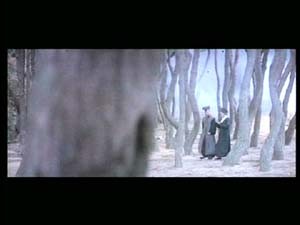
Camera dollying past trees (from Legend of the Mountain)
In retrospect, Come Drink With Me, which was both a critical and commercial success in Hong Kong for its production company, Shaw Brothers, seems to be Hu’s most conventional film, and the one that most closely converges with Hollywood codes. For a while a “romantic” couple take centre stage: a “drunken knight” (played by Yue Ha) rescues Golden Swallow and they both survive a confrontation with the villains. Surprisingly, Hu opted to leave Shaw Brothers, and made his next film, Longmen Kezhan (Dragon Gate Inn, 1966–68) in Taiwan, for the Union Film Company. Perhaps he was already looking for greater freedom away from the commercialism of the Shaws, and it is evident in Dragon Gate Inn that the director was departing from Western narrative conventions. So much information is given at the opening of the film establishing the historical and socio-political coordinates that it is almost impossible to digest all of it; many heroic characters die at the end after facing seemingly insurmountable odds; both are situations that were unfamiliar to spectators of Hollywood entertainment. Also, stylistically, Hu elaborates and extends the build-up to confrontations in the inn, and “plays” with shot composition and rhythmic editing, especially highlighting the importance of the look. We begin to feel the intensity of a character’s gaze. Here the female star, Shangguan Lingfeng, gets top-billing and, like Cheng Pei Pei she cross-dresses, posing as Chu Huei, the “brother” of Chu Chi (played by Sieh Han). Following the aforementioned introduction, Hu provides a stunning fifteen minutes of exterior cinematography, where every shot is beautifully staged and composed and where the colourful (historically accurate) costumes are set off against a muted, greyish, rocky, natural landscape. Even more striking is the scene where Chu Huei returns to the inn and fights Mao Tsung-Hsien (played by Han Ying-Chieh), the agent of a eunuch (characters who recur often in Hu’s films). With arrows flying through the air and acrobatic moves made even more dynamic and exciting by using the full width of the widescreen frame and editing on the pulse, at the instant something or someone touches the frame edge—what David Bordwell terms the “glimpse”—Hu establishes himself as the true “master” of cinematic action. 5 In addition, Dragon Gate Inn is the film which clearly introduces principles and effects from Beijing opera, including the use of minimal, percussive, musical instrumentation such as the ban (wooden board). 6
Some three years or so before seeing Raining in the Mountains I had eagerly anticipated watching films by King Hu because I had read Tony Rayns’ seminal and still definitive article in Sight and Sound, “Director: King Hu.” 7 I had also learned of the belated screening of A Touch of Zen at the Cannes International Film Festival in 1975 which led to it being awarded the Grand Prix for “superior technique.” Consequently, this was the King Hu film I most wanted to see, and while visiting my mother in the wilds of Norfolk, England for Christmas 1982 I “glimpsed” part of a scanned English sub-titled version of it on her black-and-white TV, enough to make me long to see it complete, and on the screen. Having now seen at least two full length (165 and 189 min.) versions of A Touch of Zen, I can now re-state what I have told film students on more than one occasion, and that is, if forced to choose just one film, out of the thousands I have seen (a ridiculous proposition, certainly), to represent what I love most about the cinema—a combination of exhilarating, entertaining action and poetic, visual beauty—I would most likely choose this one, even though it is not a “perfect” film. For one thing, it contains my favourite action sequence in the history of cinema, where Hsu (or Xu) Feng as Miss Yang Huizhen (the xia nü, “knight lady” of the film’s Chinese title) and her little band of men fight their first battle in the bamboo forest, halfway through the film. Both Bordwell and Teo have argued that Hu’s style derives in part from Japanese action films of the early 1960s, and one can certainly see echoes of Kurosawa’s lateral “running trucks” in the forest of his Rashomon (1950). 8 But in no other director’s work can we find the exquisite combination of camera movement and action, with actors bouncing through the scope frame on hidden trampolines, providing a sine-wave-like movement—which, I am convinced equates with the graceful movement of Tai Chi—and where the sound of flapping skirts in the breeze accompanies “glimpse” editing to allow Hsu Feng to fly through the air and dive bomb her opponent. And, who can forget the Chinese operatic, percussive score of bamboo saplings chopped and felled rhythmically to block the warrior opponents’ paths.
Action isn’t everything in A Touch of Zen, the longest and most complex of Hu’s finished projects. As its English title suggests, it is concerned with spirituality. Richard Combs wrote that the film “spreads itself out in space and time, through three distinct narrative sections, which elaborate the film first in personal, then in political and finally in religious terms, each being shed like a successive layer of skin.” 9 The first “section” contains some wonderfully atmospheric scenes set in old decaying buildings and overgrown gardens, which need to be seen on screen (rather than video) to appreciate their subtleties of decor, light and shadow. It is this section which is based on the (very) short story “Xia Nü” (or, “Hsia Nu,” The Magnanimous Girl) written by Pu Sung-Ling, and it introduces Xu Feng as the mysterious “girl next door” to the young scholar, played by Shih Chun. Part of the intrigue here centres around whether or not she is a ghost, but in the second section she is revealed to be a warrior, indeed, and she leaves her child (conceived during a single, magical night of love) for the scholar to raise, while she fights for their freedom! This incredible turn of events is one of many instances in Hu’s work which mark it as feminist before its time, and his next feature film, Yingchun Ge zhi Fengbo (The Fate of Lee Khan , 1973) presents no fewer than five young women in central action roles.
Like many creative forces in cinema before him (starting with D.W. Griffith and Eric von Stroheim in the Hollywood silent era), King Hu had a film, A Touch of Zen butchered by commercial interests, and after its box office failure in 1971 he signed with Hong Kong’s Golden Harvest to make his next two films. Even though they were designed to make money, we find the director still experimenting here with the setting of the inn—The Fate of Lee Khan—and the choreography of action in both Lee Khan and Zhonglie Tu (The Valiant Ones, 1975). I personally prefer the humour and gender balance on display in the former film to the testosterone charge and nationalist theme of the latter, but Stephen Teo makes a very strong case for the greatness of The Valiant Ones partly for its exposition of “valour” and “heroism.” 10
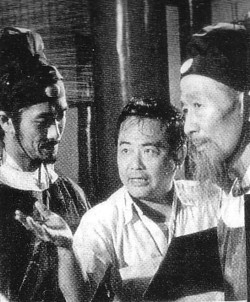
Hu giving instruction on The Valiant Ones (photo taken from Transcending the Times: King Hu & Eileen Chang, The 22nd Hong Kong International Film Festival (Provisional Hong Kong Urban Council, 1998)
Where I differ from other King Hu supporters, is that I feel he continued to experiment with the medium of cinema very successfully during the remainder of his career. 11 But, many do agree on the status of his two films made in Korea (between 1977 and 1979), Raining in the Mountains and Shan Zhong Chuanqi (Legend of the Mountain), which represent collectively, for me, the most beautiful work in his oeuvre. Hu had always struggled to find the perfect locations for his films, and, he clearly had run out of options in Hong Kong and Taiwan. Unfortunately at that time he was unable to return to his homeland and shoot in Mainland China, but found the next best option in the mountains of Korea. I like to think that he had seen Shin Sang-Ok’s oneiric masterpiece, K K’um (The Dream, 1967) and had been inspired by it to choose the Buddhist temple setting. In any event these two films demonstrate that Hu was always more interested in Chinese culture and history in general than its martial arts in particular: the care with which he sets his human characters physically and cinematically in the natural landscape and the old rooms, hallways and courtyards of the temple is truly extraordinary. As well, in Legend of the Mountain he manages to fuse the natural with the supernatural, and by casting the young Sylvia Chang as a (possible) ghost he gave us two ethereal female beauties in the same film (Xu Feng, of course, being the other).
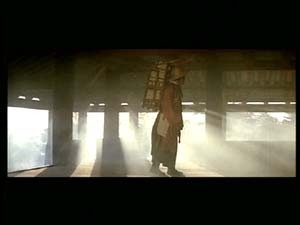
Pictorial beauty in Legend of the Mountain
PS: A shorter version of this essay appeared in the Festival Catalogue, The 5th Puchon International Fantastic Film Festival, PiFan 2001, July 12-20, p. 136-139) PiFan.
________________
Discussing King Hu: Cinebus Interviews Peter Rist
The following is a rough translation by Mijeong Lee, of the interview conducted by the Korean weekly film magazine, Cinebus, on July 16, 2001. Parts of the interview had to be reconstructed (and may have been mistranslated by the editors of the magazine).
PR: Most people consider that the most important aspects of narrative film are the content, the characters and the acting but after seeing King Hu’s films one can appreciate other elements. He emphasised editing, movement and colour. A Touch of Zen is an outstanding film of action with thrilling and aesthetically beautiful images (even though, as a film, it may not be “perfect”).
Cinebus: The representation of women’s characters in King Hu’s film is very strong.
PR: His films present an aspect of the “feminine” which is unusually strong. That might be a reason why I like his films more than others in the wu xia genre. On the other hand, women in John Woo’s films are presented as very simple, plain, one dimensional characters. Female martial arts characters had existed before King Hu, but the xia nü, “chivalrous woman warrior” character started to find life in his films.
Cinebus:: How would you compare King Hu to Kurosawa Akira?
PR: Kurosawa has been such a big influence on Hollywood directors, and his films are strong in action and speed. But, his films looked very “western” in their style to the Japanese and vice versa. (To westerners they seemed very Japanese in style.) And such is the case of Ang Lee on the contemporary film scene. Relatively speaking, King Hu’s images (mise-en-scene) are more consistently attractive and beautiful.
Cinebus: What is the ‘glimpse’ in film?
PR: It can be applied to scenes of realistic and dynamic actions, where editing is integral to the effects achieved. This definition is based on David Bordwell’s, and I might have a slightly different interpretation. It is true that director King Hu showed us the best editing techniques to be found in Chinese cinema, but the editing technique was not just used to hide or avoid something, or to tighten loose actions. His directing was even stepped forward to show not only dynamic actions but also following (catching up with) the performers.
Cinebus: Can you talk about the role of the martial arts director in Chinese martial arts films?
PR: I think the concept of martial art director has started with King Hu. At first, he had a lot of support from Han Yingjie [the martial arts director on Come Drink With Me, Dragon Gate Inn and A Touch of Zen]. I have understood this influence brought with it a strong representation of opera in his films. Since this time, the role of the martial arts director has taken on more weight in Chinese-language cinemas.
Cinebus: What about the influence of Shin Sang-Ok?
PR: There is a similarity in Dream (1969) by Shin Sang-Ok to King Hu’s films in terms of the “emotion” emanating from the “scenery” or landscape. I guess there is no indication that either director saw the other’s films. But, I like to think that King Hu maybe saw Shin’s work, and that this could have been an inspiration for him to shoot two films in Korea. In any event, Hu’s films are different from other Hong Kong films made in those days; rather, they look more similar to Korean films of the 1960s.
Cinebus: What influence has King Hu’s films brought to contemporary Hong Kong cinema?
PR: We can see his powerful influence in most Hong Kong films that try to show any type of action. As we now know, director Ang Lee borrowed a scene from A Touch of Zen. I think it could be possible to find the origins of the work of directors such as John Woo, Tsui Hark and Ching Siu-tung in King Hu’s film work.
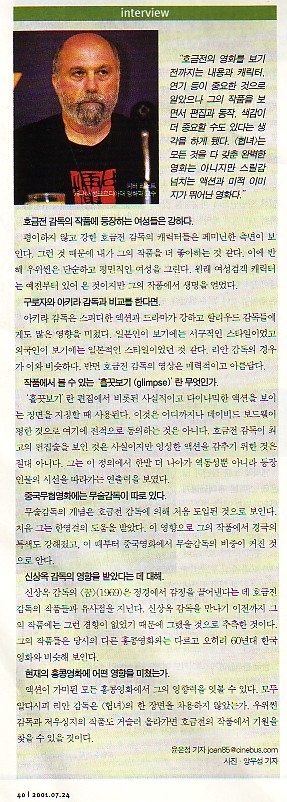
Cinebus # 47, July 16, 2001, p. 40
Notes
- Wu translates into English, variously, as “military,” “valiant,” “fierce,” and “of combat,” while xiá connotes “chivalry.” Thus, wu xiá refers to “a martial world informed by the code of chivalry, “ (in Ng Ho’s words). Pian means “film.” See Ng Ho’s “Jiang Hu Revisited: Towards a Reconstruction of the Martial Arts World,” in Lau Shing-hon, ed., A Study of the Hong Kong Swordplay Film (1945-1980), The 5th Hong Kong International Film Festival (Hong Kong Urban Council, 1981, rev. ed., 1996), p. 85. ↩
- This is, of course, an extremely complex issue. Major retrospectives of Hu’s work were mounted in Taipei in 1980 and 1999, and in Hong Kong in 1979, 1985 and 1998, but, it is in Japan that his legacy is, perhaps, best known. After a retrospective in 1988, a number of his films were released on laser disc, and in 1997 the very first complete King Hu monograph was published by Soshi-sha in Tokyo, in the Japanese language: King Hu buyo den’ei sappo: A Touch of King Hu, written by Yamada Koichi and Udagawa Koyo. ↩
- Liu Damu quotes Luo Qing arguing (in 1977) that Shuo Jian Pian (On the Sword) was the “first wu xia short story, if not the first Chinese short story proper.” This was written during the Warring States Era, 403–221 B.C. In, “From Chivalric Fiction to Martial Arts Film,” Lau Shing-hon, op. cit., pp. 47–62. ↩
- For a thorough overview of the “seminal” nature of Come Drink With Me, see Stephen Teo’s “Only the Valiant: King Hu and His Cinema Opera,” in Law Kar, ed., Transcending the Times: King Hu and Eileen Chang, The 22nd Hong Kong International Film Festival (Provisional Urban Council of Hong Kong, 1998), pp. 19–20. ↩
- David Bordwell writes that “Hu makes his action faster than the eye—and even, it seems, the camera—can follow. Often we are allowed only a trace of the warriors’ amazing feats. We do not see action as much as glimpse it.” In “Richness through Imperfection: King Hu and the Glimpse,” Law Kar, op. cit., p. 33. ↩
- I have never witnessed any Chinese opera performances live, and I have never watched any Cantonese or Beijing opera films. My experiences are limited to seeing snatches of Chinese opera as pastiche or parody in Hong Kong entertainment—e.g., Tsui Hark’s Dao Ma Dan (Peking Opera Blues, 1986), Johnnie To and Wai Ka Fai’s Wu Yen (2000)—or under the critical gaze of Mainland Chinese filmmakers—e.g., Xie Jin’s Wutai Jiemei (Two Stage Sisters, 1965), Chen Kaige’s Ba Wang Bie Ji (Farewell My Concubine, 1992). Thus, once again I defer to Stephen Teo and his excellent discussion of the relationship between Chinese opera and King Hu’s films, op. cit., pp. 20–21. ↩
- In Sight and Sound, Vol. 45, no. 1 (Winter 1975/76), pp. 8–13. ↩
- Bordwell mentions Uchida Tomu’s Musashi Part 4 (1964) as containing a notable example of a “sustained, action-packed tracking shot,” op. cit., p. 32, while Teo favourably compares Come Drink With Me to contemporaneous “Japanese samurai pictures,” op. cit., p. 19. ↩
- Review, credits and synopsis, in Monthly Film Bulletin, Vol. 43, no. 509 (June 1976), p. 131. ↩
- op. cit., pp., 23–24. ↩
- I would make exceptions here of the un-inspiring contemporary comedy, Zhongshen Dashi (The Juveniser, 1981) and Xiao’ao Jianghu (Swordsman, 1990) in which hardly any of his work remains. But, Hua Pi zhi Yinyang Fawang (The Painted Skin, 1992) is a vastly underrated, very subtle horror film which brings the “glimpse” principle into the realm of the fantastic. I also admire Hu’s episode in Da Lun Hui (The Wheel of Life, 1983) for its visceral, wide-angle lens treatment of cape and swordplay, and though I fail to understand the director’s intentions on Tianxia Diyi (All the King’s Men, 1982), I find it to be full of intrigue and standing as another example of Hu’s desire to experiment (in this case with history and narrative form). ↩



